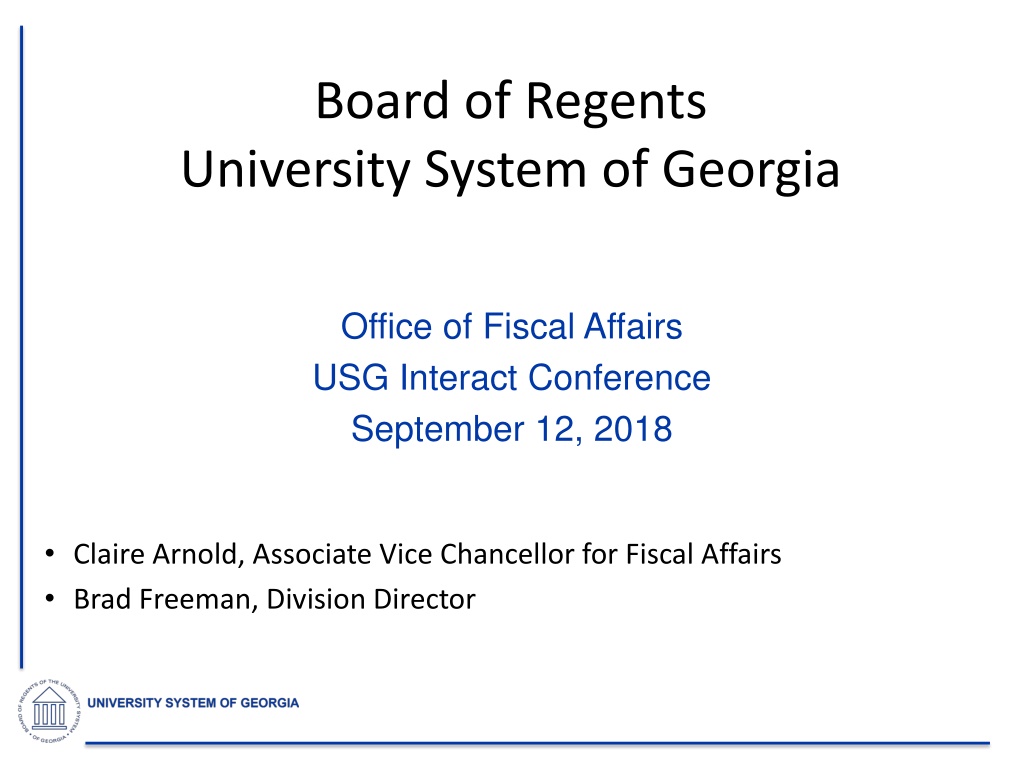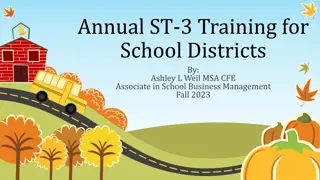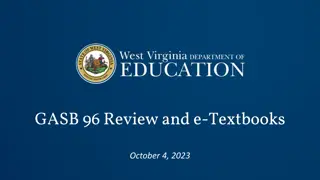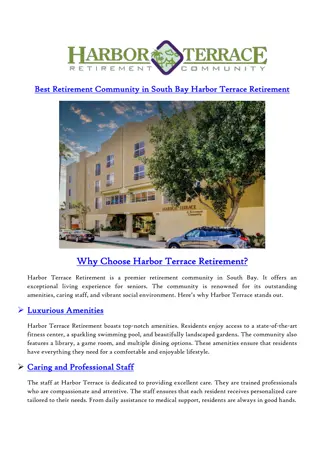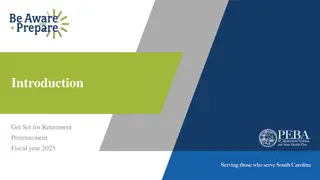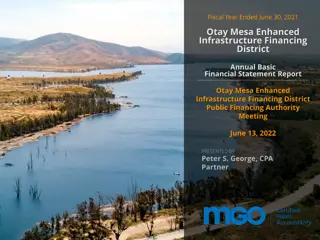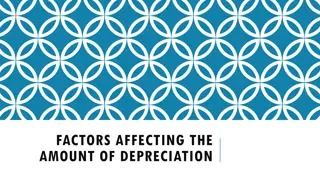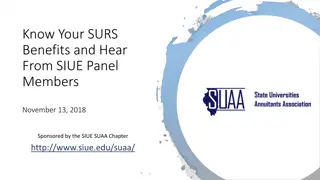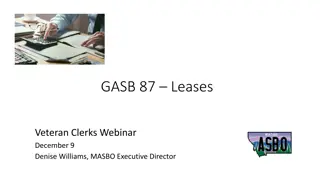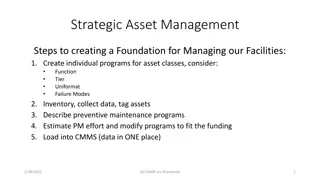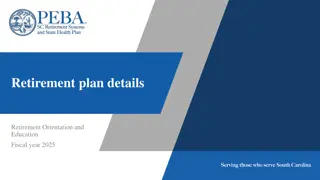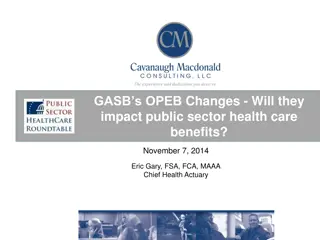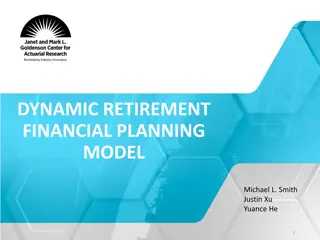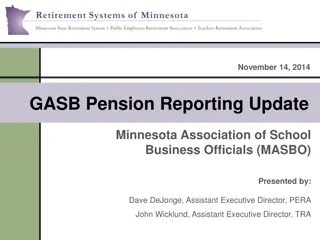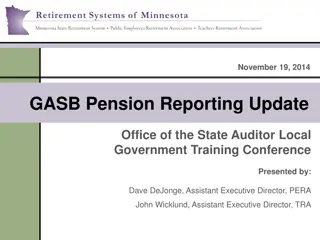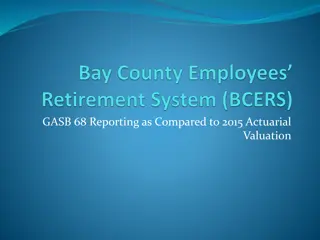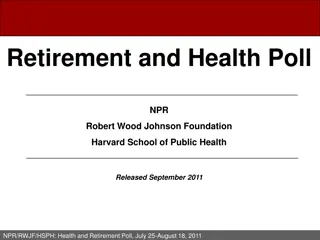Understanding GASB Statement 83: Asset Retirement Obligations
GASB Statement 83 standardizes the recognition and measurement requirements for asset retirement obligations (ARO) to enhance financial reporting consistency. Governments must recognize AROs when liabilities are incurred and reasonably estimable, based on external and internal obligating events. Measurement is based on the best estimate of current value of expected outlays, with adjustments for inflation or deflation. Examples of AROs include decommissioning nuclear reactors and removing x-ray machines. Regular evaluations and re-measurements are required for significant changes in estimated outlays.
Download Presentation

Please find below an Image/Link to download the presentation.
The content on the website is provided AS IS for your information and personal use only. It may not be sold, licensed, or shared on other websites without obtaining consent from the author. Download presentation by click this link. If you encounter any issues during the download, it is possible that the publisher has removed the file from their server.
E N D
Presentation Transcript
Board of Regents University System of Georgia Office of Fiscal Affairs USG Interact Conference September 12, 2018 Claire Arnold, Associate Vice Chancellor for Fiscal Affairs Brad Freeman, Division Director
GASB Statement 83 Certain Asset Retirement Obligations Overview Standardizes requirements on the recognition and measurement for asset retirement obligations, other than landfills, to reduce inconsistency in financial reporting and enhance comparability. Effective for fiscal year 2019 2
GASB Statement 83 Certain Asset Retirement Obligations Governments should recognize the Asset Retirement Obligations (ARO) when the liability is incurred and reasonably estimable. The liability is incurred by both an external obligating event (i.e. external laws, a legal contract, or the issuance of a court judgement) and an internal obligating event that requires the government to retire the asset (i.e. contamination, abandonment, or placing into operation a tangible asset that is required to be retired). Developing a plan to retire an asset is not, by itself, an internal obligating event. ARO measurement is to be based on the best estimate of the current value of the outlays expected to be incurred. The current value is the amount that would be paid if all equipment, facilities, and services included in the estimate were acquired at the end of the current reporting period. Governments should recognize a deferred outflow of resources when an ARO is recognized at the initial measurement value. Deferred outflows of resources should then be reduced and recognized as an outflow of resources (i.e. expense) in a rational manner over a period of time. After initial measurement, governments are required to adjust the current value of their AROs for the effects of inflation or deflation annually. Also, annually, governments are required to evaluate all relevant factors related to an ARO and to determine if any of those factors are expected to increase or decrease the estimated asset retirement outlays associated with an ARO. Governments should only re-measure an ARO when the results of this evaluation indicate a significant change in the estimated outlay. Some examples of significant change include changes in technology, legal or regulatory requirements, and the type of equipment, facilities, or services that will be used to meet the obligations to retire the tangible capital asset. 3
GASB Statement 83 Certain Asset Retirement Obligations Examples of Asset Retirements: Decommission a nuclear reactor Remove and dispose an x-ray machine Remove and dispose of wind turbines Closure and removal of a sewage treatment facility 4
GASB 83 Certain Asset Retirement Obligations Asset Retirement Obligations ARO An institution has an ARO if at the time of the asset being put into service, the institution knows with certainty that they will incur some cost to retire the asset in the future. An asset does not qualify as an ARO if it may have to or mightpossibility have to do something to it upon retirement. An ARO is for those assets whereby there is a haveto pay to clean up or decommission the asset that is known by the reporting date. ARO is different than Pollution Remediation (GASB 49), in that under GASB 49 there is it is not known at the beginning of the assets life that there is something to do upon retirement, but rather than something has been polluted and there is an obligation at that point. In order to quality for ARO, there has to be a legal requirement or commitment to perform future retirement activities. Institutions with X-RAY machines and MRI Machines are very likely going to be ARO because of federal laws. 5
GASB Statement 83 Certain Asset Retirement Obligations You will be required to disclose the following in your financial statements: General description of the ARO General description of the associated tangible capital asset Source of the obligations (i.e. law, regulation, or contract) Methods and assumptions used to measure the liabilities Estimated remaining useful life of the associated tangible capital asset How any legally required funding and assurance provisions associated with the ARO are being met (i.e. insurance policies, letters of credit, and guarantees by other entities) Amount of assets restricted for payment of liabilities, if not separately displayed in the financial statements. 6
GASB Statement 83 Certain Asset Retirement Obligations Potential Retirement Costs Excludes . Cost of planning to sell/dispose tangible capital assets Prepping an asset for alternative use Pollution mitigation and landfill closure Routine maintenance Replacement of capital asset parts 7
GASB Statement 83 Certain Asset Retirement Obligations Evaluation of ARO Activity List of assets with potential ARO List of legal or contractual obligations, court judgements related to the assets listed Methodology to use to estimate liability Estimate of your institution s liability by asset 8
GASB Statement 83 Certain Asset Retirement Obligations Evaluation of ARO Activity USG Institution Name: Institution Contact: ASSET ID ASSET DESCRIPTION FUND ORIGINAL COST DATE OF INSERVICE USEFUL LIFE ARO REQUIREMENT ESTIMATED COST OF DISPOSAL DISPOSAL CALCULATION METHODOLOGY Asset ID Asset Description Fund Original Cost Date of Inservice Useful Life ARO Requirement Legal, federal statute, federal regulation, state statute, contract, grant award, etc. Estimated Cost of Disposal Disposal Calculation Methodology Actual, Estimate, Historical, etc. 9
GASB Statement 83 Certain Asset Retirement Obligations Evaluation of ARO Activity USG Institution Name: Institution Contact: ASSET ID ASSET DESCRIPTION FUND ORIGINAL COST DATE OF INSERVICE USEFUL LIFE ARO REQUIREMENT ESTIMATED COST OF DISPOSAL DISPOSAL CALCULATION METHODOLOGY Excel Evaluation File will be distributed via email on September 17, 2018 Due to USO Friday, November 16 Upload Completed Evaluation to MoveIt Fiscal Affairs/Accounting and Reporting/ARO Folder Include Entity Name in file Title 10
GASB Statement 84 Fiduciary Funds Statement establishes criteria for identifying fiduciary activities. The focus of the criteria is on: whether a government controls the assets of the fiduciary activity, and the beneficiaries with whom a fiduciary relationship exists. A government is considered in control of the assets if the government holds the assets or has the ability to direct the use of the assets in a manner that provides benefits to the specified or intended recipients. The assets also cannot be derived from the government s own source revenues (or from government-mandated or voluntary non-exchange transactions). In addition, with respect to the assets related to the specified or intended beneficiaries, one or more of the following characteristics must be present: 1) Be administered through a trust 2) The government itself is not the beneficiary 3) Dedicated to providing benefits in accordance with the benefit terms 4) Legally protected from the government s creditors 5) For the benefit of individuals and the government has no administrative or direct financial involvement with the assets 11
GASB Statement 84 Fiduciary Funds Reporting an activity meeting the above criteria should be reported in the basic financial statements in one of the following four fiduciary funds, as applicable: 1)Pension (and other employee benefit) trust funds 2)Investment trust funds 3)Private-purpose trust funds 4)Custodial funds 12
GASB Statement 84 Fiduciary Funds Custodial funds Statement of Fiduciary Net Position Assets Deferred Outflows Liabilities Deferred Inflows Fiduciary Net Position Statement of Changes in Fiduciary Net Position Additions Deductions 13
GASB Statement 84 Fiduciary Funds The use of Agency funds has been eliminated with GASB 84 and replaced with Custodial funds. Next Steps: Each agency fund will have to be evaluated Non-custodial activity will have to be moved to the appropriate fund Retrospective GASB Statement Effective for Fiscal Year 2020 Beginning July 1, 2019 14
GASB Statement 84 Fiduciary Funds Agency Funds Analysis: Current Agency Fund Name: Project ID/Department ID Number: Description/Purpose of Agency Funds: Questions: 1. Does institution control assets of fiduciary activity? 2. Who is beneficiary of assets? Fiduciary Fund: Yes or No If Yes Determine type of fiduciary fund 1)Pension (and other employee benefit) trust funds 2)Investment trust funds 3)Private-purpose trust funds 4)Custodial funds There is no trust agreement or equivalent If No Provide analysis/determination of reclassification to another funds 15
GASB Statement 84 Fiduciary Funds Example Discussion: Club Accounts Scholarship Fund with Trust Agreement Scholarship Fund with no Trust Agreement Fiscal Affairs Conference Account Direct Loan Program Hope Program 16
GASB Statement 84 Fiduciary Funds Next Steps: Non-custodial activity will have to be moved to the appropriate fund before June 30, 2019 Retrospective GASB Statement Effective for Fiscal Year 2020 Beginning July 1, 2019 NOTE: BTA s fiduciary activities should be reported in separate fiduciary fund financial statements Resources expected to be held 3 months or less can be reported instead in the statement of net position, with inflows and outflows reporting as operating cash flows in the statement of cash flows. 17
GASB Statement 84 Fiduciary Funds Next Steps: Non-custodial activity will have to be moved to the appropriate fund before June 30, 2019 Retrospective GASB Statement Effective for Fiscal Year 2020 Beginning July 1, 2019 NOTE: BTA s fiduciary activities should be reported in separate fiduciary fund financial statements Resources expected to be held 3 months or less can be reported instead in the statement of net position, with inflows and outflows reporting as operating cash flows in the statement of cash flows. 18
GASB Statement 87 The newly issued GASB Statement 87 on leases will fundamentally change lease recognition, measurement, and related disclosures for both government lessees and lessors. The major changes outlined in GASB 87 are: Leases will be classified as short-term, contracts that transfer ownership, and all other. Leases that extend beyond 12 months will have a balance sheet impact on both the lessee and lessor. For all leases other than non-short-term, the lessee will recognize the intangible use asset, and the lessor will continue to depreciate and account for the lease asset. Financial statement disclosures and schedules will be required for contracts that transfer ownership and non-short-term leases. There will be no disclosure requirement for short-term lease outflows. 19
GASB Statement 87 Definition of a lease will include control of a nonfinancial asset GASB 87 defines a lease as a contract that conveys control of the right to use another entity s nonfinancial asset (the underlying asset) as specified in the contract for a period of time in an exchange or exchange-like transaction. To determine whether control exists, your government should assess whether it has both the ability and rights to use the asset. You should also consider the nature of the asset and how it will be used. Nonfinancial assets include land, equipment, buildings, and vehicles. 20
GASB Statement 87 Leases are currently classified as either operating or capital, based on a four-factor test. GASB 87 will sort lease agreements into three categories: short-term leases, contracts that transfer ownership, and all other leases. The four- factor test will be eliminated, as will the terminology of operating and capital leases. Short-term leases are defined as leases that have a maximum possible term of 12 months or less, including any options to extend. Leases that are month-to-month are considered short-term. Short-term leases will be accounted for similarly to operating leases, with lease payments being recorded as expense or revenue by the lessee or lessor. Contracts that transfer ownership -If the underlying asset transfers ownership to the lessee by the end of the contract, the transaction should be reported as a financed purchase of the underlying asset by the lessee, or sale of the asset by the lessor. All other leases Any agreement that doesn t qualify as a short-term lease or ownership transfer contract will fall into this category, with implications for both lessees and lessors. For lessees At the commencement of the lease term, the lessee should recognize a lease liability and an intangible right-to-use lease asset (lease asset). The lease liability will be measured at the present value of payments expected to be made during the lease term. Lease payments will result in reduction of the lease liability and recognition of interest expense. The lease asset will be measured as the sum of the initial measurement of the lease liability, initial direct costs, and lease payments made prior to commencement, less any lease incentives. The lease asset will be amortized over the shorter of the lease terms or the useful life of the underlying asset. For lessors At the commencement of the lease term, a lessor should recognize a lease receivable and a deferred inflow of resources. The lease receivable should initially be measured at the present value of lease payments expected to be received during the lease term. Lease receipts (payments from lessee) will result in reduction of the lease receivable and recognition of inflows and revenues. The deferred inflow of resources should be measured as the sum of the initial measurement of the lease liability and lease payments received made prior to commencement, less any lease incentives. The lessor should not derecognize the asset underlying the lease and continue to record depreciation, as applicable. 21
GASB Statement 87 Impact: Effective for Fiscal Year 2020 Retrospective Debt Ratios State of Georgia Statutory Debt Limits Next Steps: Analysis of current leases Lease Data Information due January 2019 22
Taxable Fringe Benefits Uniforms/Clothing Clothing expenses and allowances are taxable fringe benefits, unless an exclusion applies. For a fringe benefit to be taxable, it need not be furnished directly to the employee by the institution, as long as the benefit is provided in connection with the performance of services for the institution. The Tax Court has established three criteria for the cost of clothing to be considered an ordinary and necessary business expense: the clothing is required or essential in the individual s employment; the clothing is not suitable for general or personal wear; and the clothing is not so worn. EXAMPLES of clothing items that may be excluded as working condition fringes: Uniforms worn by police officers, health care professionals, delivery workers, letter carriers, transportation workers; chef s coats; certain athletic uniforms. Protective clothing such as safety glasses, hard-hats, work gloves, steel-toed work boots, and other clothing required by OSHA regulations. Uniform/clothing that is rented and/or returned to the university and is maintained in a central area where the clothing is issued to the employee. The clothing must be kept and cleaned on university property and reissued on a regular basis. The employee may not assume personal possession of the clothing. 23
Taxable Fringe Benefits Uniforms/Clothing De Minimis Fringe Exclusion IRC 132(e); Reg. 1.132-6 De minimis fringe benefits are benefits in which the value is so small in relation to the frequency in which it is provided, that accounting for it is unreasonable or administratively impracticable. For purposes of the de minimis exclusion, the term employee means any recipient of a fringe benefit. Reg. 1.132-1(b)(4) For USG s purposes, clothing items of nominal value ($75 or less) provided infrequently (no more than two times per year) may be excluded from taxation as a de minimis fringe benefit. Note: If either the value or frequency limits are exceeded, the entire value of the benefit (not just the excess amount) is taxable. Reg. 1.132-6 (d)(4) EXAMPLES of clothing items that may be excluded as de minimis fringes: Low-value clothing bearing the University or department name, such as facilities services (maintenance) uniforms. These uniforms typically have a matching shirt and pant. T-shirts provided to employees to wear to promote a campus event An apparel allowance, or the value of merchandise credit provided to certain employees that allows them to acquire apparel and goods directly from an outside vendor, is a taxable fringe benefit. 24
Taxability of Employee Uniforms/Clothing Periodic allowance payments made to employees for the purchase and maintenance of specific articles of employer-required uniforms are not taxable to the employees to the extent that the allowances are used to pay for uniforms are not adaptable to general use, and are not worn for general use, and the employees substantiate the expenses. If the employer does not require substantiation, the allowance is taxable as wages and subject to withholding when paid. Example: An agency is required to reimburse certain employees for shoes under a union contract. The shoes are not safety shoes. Because the shoes are adaptable for general wear, the reimbursements are included as wages to the employees even if the employer is required to make the payment. 25
Taxability of Employee Uniforms/Clothing Recent court cases may provide us enough flexibility to continue to provide grounds, maintenance and food service employees with uniforms without having to reflect as taxable compensation as they are characterized as torn or stinky (Madsen v. Commissioner, bulky, utilitarian in fashion and unsuitable for personal use (Jackson v. Commissioner) or dirty and stained (Cross v. Commissioner). Polo Shirts, jackets, etc. with Institution emblem will not meet the IRS definition to be excluded from W-2 Taxable Compensation. 26
Expenditures - Things to Consider External and internal audits IRS Compensation audits Travel Per Diem $28 per day in State/$36 per day High Cost Area in State/ GSA Rate (U.S. General Services Administration) Lodging - Hotels/Condos/Houses Cash Advances Executive Fringe Benefits Public Scrutiny/Newspaper Test Review of financial transaction activity 27
Expenditures - Things to Consider All purchases are monitored by DOAS purchasing auditors on a continuous basis P-Card purchases are monitored by DOAS on a continuous basis All P-Card purchases over $100 requires prior approval/purchase order P-Cards are not allowed to be utilized to pay for employee travel costs (lodging, meals, etc.) 28
Expenditures - Things to Consider P-Card Purchases OCGA 50-5-83 Prohibits the issuance of cards to employees of foundations associated with any State Entity. Additionally, DOAS has included in the State Pcard policy that prohibited the use of the card by a State Entity employee when foundation funds will be use. New Statement needs to be added to P-Card approvals Although the original funding source associated with the funds utilized for this purchase may have been provided by one of the College/University s foundations through a grant, gift, etc., the expenditure is being made with institutional funds for institutional purposes. Must be added to all pcard preapprovals no later than November 1, 2018 29
Other Topics Census Data Testing Early Student Billing for Fall 2019 Federal Procurement Requirements BPM Section 3.1.4.4 Updated Studies Abroad Section of BPM Fiscal Affairs Workshop December 4 and 5 30
